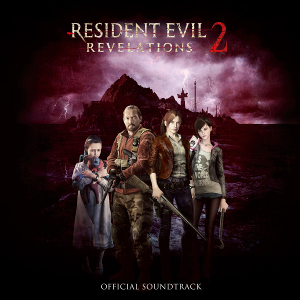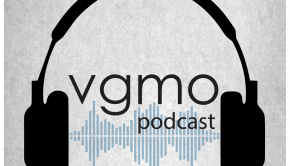Resident Evil -Revelations 2- Original Soundtrack
 |
Album Title: Resident Evil -Revelations 2- Original Soundtrack (Biohazard -Revelations 2- Original Soundtrack) |
| Record Label: Capcom (Limited Edition); Suleputer (JP Edition); Sumthing Else Music Works (NA Edition) |
|
| Catalog No.: N/A |
|
| Release Date: March 18, 2015; March 19, 2015; March 17, 2015 |
|
| Purchase: Download at Sumthing Else |
Overview
In 2012, Capcom released three successive Resident Evil titles: Revelations, Operation Raccoon City, Resident Evil 6. While the latter titles received a poor critical reception, Resident Evil: Revelations was heralded as a polished title that returned the series to its ‘survival horror’ roots, inspiring Capcom to release a high-definition version in 2013 and a direct sequel in 2015. Released episodically, the score for Resident Evil: Revelations 2 unfolded with the game’s storyline. Kota Suzuki and Ichiro Kohmoto returned to pen the music, combining arrangements of Revelations‘ music with numerous new tracks. The full soundtrack has been released in three forms. A three-disc 102-track set was available with e-Capcom limited edition version of the game in Japan. In addition, 95-track digital albums were distributed by Suleputer in Japan and Sumthing Else Music Works in the West.
Body
Whereas the original Revelations went for an all-out operatic approach, the sequel generally tones things down in favour of more subtle and personal sounds. This is evident from the very first track, an arrangement of “Lost Sea”. While the original was already a dark tune, this adaptation from Suzuki and guest artist Nima Fakhara takes an even more downbeat approach: shifting the tempo from andante to largo, focusing on solo cello rather than full orchestra, and incorporating all sorts of eerie post-production effects. Some of the timbres produced are utterly beautiful, setting the stage perfectly for the adventure to unfold. That said, the rendition might be too subdued for some and the music is probably less widely accessible than the original version. Other favourites are arranged elsewhere in the soundtrack, with “Lost” enchained in a minimalistic arrangement and “Revelations” distorted into a ghostly cue at the start of the second disc. Even Mozart’s “Lacrimosa” features, but in a solo piano rendition rather than its Dies Irae precedent. Only “Revelations -Cliffhunger Ver.-“, fittingly featured at the climax of the soundtrack, returns to the grandiose, gushing approach we have come to expect from Revelations.
The original tracks on the soundtrack generally continue this approach to map out the unfolding storyline. The brief piano-focused tracks representing Barry, Neil, and Natalia effectively contrast the humanity of their protagonists with the grimness of their circumstances. Ambient scene-setters such as “Fishing Village” and “Radio Tower 1” also balance depictions of beauty and horror very effectively. Upping the stakes for the game’s penultimate location, “The Mines 1” creates the perfect atmosphere with its guttural and percussive elements, while “The Mines 2” evokes memories of the original game with its expressive, ambiguous progressions for violin and piano. Tracks like these tend to resemble sketches more than fully-fledged pieces, providing glimpses into the psyche of the characters or the environments that surround them before moving on to the next ‘horror’. But while tracks like these work well in driving forward the episodic adventure of Revelations 2, they’re certainly not as developed or gripping as the background music for past titles such as Revelations, Code: Veronica, or Resident Evil 2. Those expecting sweeping scene-setters like “Terragrigia Panic II” or action anthems like “Ride on Sea” might therefore end up disappointed with Capcom’s latest offerings.
While the introspective approach of Revelations 2‘s soundtrack has its merits, it’s a pity that the game’s music all too often seems to be completely subservient to the visuals. Much like Resident Evil 6‘s endless cinematic cues, most of the cutscene tracks on the soundtrack are brief, unmemorable pieces of underscore. The four “Critical Decision” tracks, for instance, serve their purpose in context but fail to impress stand-alone listeners with their vanilla orchestrations and abrupt playtimes. Even “Opening -Claire’s Side-” is a hackneyed mess. Ambient background music such as “Sewers 1” and “Insanity 1” are examples of by-the-book horror scoring with their suspended chords, tremolo strings, and droning sounds. Prepared instrument use is abundant in many tracks such as these and, while effective in tracks such the opener, it all too often sounds clichéd and gimmicky otherwise. Other tracks such as “Detention Center 2”, “Derelict Town 2”, “Deep Forest 1”, and “The Mines 4” are far too minimalistic to leave an impression on a stand-alone basis, more sound design than music (and hardly inspired sound design at that). A few tracks aren’t just monotonous, but rather obnoxious: “Rotten” lives up to its name, for example, interjecting a double bass note repeated ad nauseam with prepared instrument crashes.
The action tracks make up for some of these downfalls. Much like Resident Evil 4‘s “Ganado” tracks, the three-part “Afflicted” series excellently captures the motion of unstoppable hordes of ‘zombies’ — with their highly discordant, almost aleatoric progressions — and inspire much anxiety in players. For the game’s setpieces, “Up the Pace” and “Siren” blends horror orchestration with electronic elements, “Kierling 2” offers an intoxicating mixture of crisis motifs and anthemic melodies, and “Determination” proves a major highlight with its continuously building textures and tempo. The final battle tracks again distance themselves from the operatic approach of the original game’s soundtrack in favour of more subdued orchestrations nevertheless wrought with tension. Among the numerous bonus tracks are five remixes of Resident Evil 6 tracks used during the ‘Raid Mode’ minigame; irrespective of one’s attachment to the original material, these tracks are quite refreshing with their fast tempos and techno/dubstep stylings. Exclusive to the e-Capcom version of the soundtrack, there are several alternative and prototype versions of several themes at the end of the third disc, most notably the sweeping “Main Theme Pattern B”.
Summary
In an age where sequels are expected to be ‘bigger than bolder’ than their originals, Kota Suzuki and Ichiro Kohmoto made a daring decision by going ‘inwards’ for Revelations 2. But some aspects of the score are innovative and refreshing, for example the introspective arrangements of the main theme, much of the background and cinematic music is mundane. Their soundtrack consistently supports the game’s episodic storyline, but the music often fails to leave a mark on a stand-alone level compared to its predecessor and most other Resident Evil soundtracks. Only buy this soundtrack if you enjoyed the music in the context of the game or wish to check out the handful of highlights mentioned.
Do you agree with the review and score? Let us know in the comments below!
3
Posted on June 11, 2015 by Chris Greening. Last modified on June 11, 2015.














